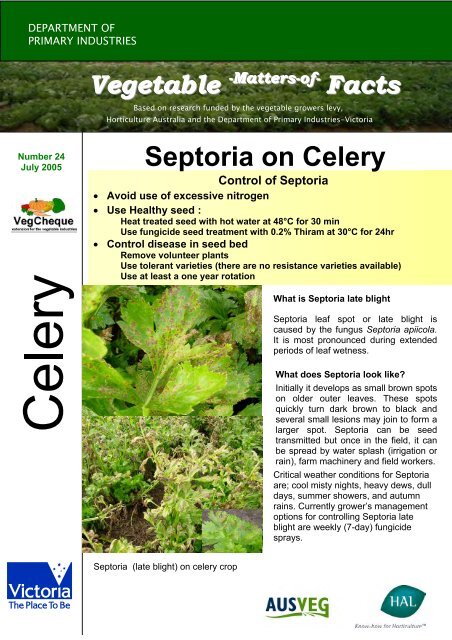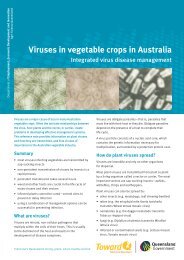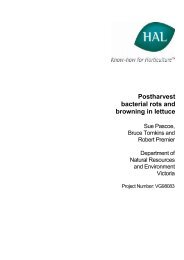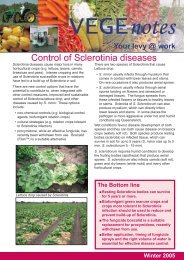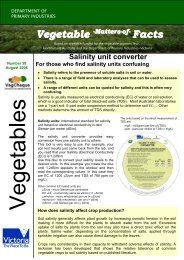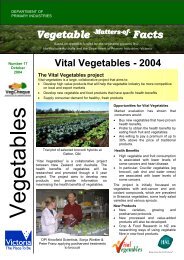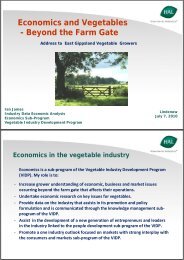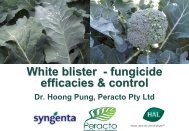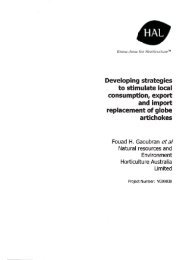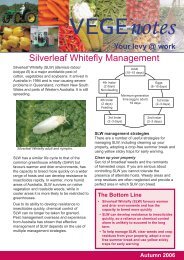Septoria on Celery - Vegetable Growers Association of Victoria
Septoria on Celery - Vegetable Growers Association of Victoria
Septoria on Celery - Vegetable Growers Association of Victoria
- No tags were found...
Create successful ePaper yourself
Turn your PDF publications into a flip-book with our unique Google optimized e-Paper software.
DEPARTMENT OFPRIMARY INDUSTRIES<strong>Vegetable</strong> - -Matters--<strong>of</strong>-- FactsBased <strong>on</strong> research funded by the vegetable growers levy,Horticulture Australia and the Department <strong>of</strong> Primary Industries-<strong>Victoria</strong>Number 24July 2005<str<strong>on</strong>g>Septoria</str<strong>on</strong>g> <strong>on</strong> <strong>Celery</strong>C<strong>on</strong>trol <strong>of</strong> <str<strong>on</strong>g>Septoria</str<strong>on</strong>g> Avoid use <strong>of</strong> excessive nitrogen Use Healthy seed :Heat treated seed with hot water at 48°C for 30 minUse fungicide seed treatment with 0.2% Thiram at 30°C for 24hr C<strong>on</strong>trol disease in seed bedRemove volunteer plantsUse tolerant varieties (there are no resistance varieties available)Use at least a <strong>on</strong>e year rotati<strong>on</strong>What is <str<strong>on</strong>g>Septoria</str<strong>on</strong>g> late blight<str<strong>on</strong>g>Septoria</str<strong>on</strong>g> leaf spot or late blight iscaused by the fungus <str<strong>on</strong>g>Septoria</str<strong>on</strong>g> apiicola.It is most pr<strong>on</strong>ounced during extendedperiods <strong>of</strong> leaf wetness.What does <str<strong>on</strong>g>Septoria</str<strong>on</strong>g> look like?Initially it develops as small brown spots<strong>on</strong> older outer leaves. These spotsquickly turn dark brown to black andseveral small lesi<strong>on</strong>s may join to form alarger spot. <str<strong>on</strong>g>Septoria</str<strong>on</strong>g> can be seedtransmitted but <strong>on</strong>ce in the field, it canbe spread by water splash (irrigati<strong>on</strong> orrain), farm machinery and field workers.Critical weather c<strong>on</strong>diti<strong>on</strong>s for <str<strong>on</strong>g>Septoria</str<strong>on</strong>g>are; cool misty nights, heavy dews, dulldays, summer showers, and autumnrains. Currently grower’s managementopti<strong>on</strong>s for c<strong>on</strong>trolling <str<strong>on</strong>g>Septoria</str<strong>on</strong>g> lateblight are weekly (7-day) fungicidesprays.<str<strong>on</strong>g>Septoria</str<strong>on</strong>g> (late blight) <strong>on</strong> celery crop
Evaluati<strong>on</strong> <strong>of</strong> a disease forecastingmodel to manage late blight (<str<strong>on</strong>g>Septoria</str<strong>on</strong>g>)in <strong>Celery</strong> (VG-04016)Currently DPI <strong>Victoria</strong> is c<strong>on</strong>ducting trials toevaluate the TomCast forecasting model for<str<strong>on</strong>g>Septoria</str<strong>on</strong>g> late blight in celery. TomCast is aweather based disease predictive model whichcan be used to improve timing <strong>of</strong> fungicideapplicati<strong>on</strong>. In North America celery sprayed bythe TomCast disease predictive model hasresulted in the reducti<strong>on</strong> <strong>of</strong> <strong>on</strong>e to three spraysper crop, without loss <strong>of</strong> quality or yield.How it works?A weather stati<strong>on</strong> in the field recordstemperature and leaf wetness informati<strong>on</strong>, whichis fed into the TomCast model. When adesignated threshold is reached a spray isapplied. Crops are sprayed <strong>on</strong>ly whenc<strong>on</strong>diti<strong>on</strong>s are c<strong>on</strong>ducive to the disease ratherthen <strong>on</strong> a weekly (calendar) basis.Are you <strong>on</strong> our mailing list?If you would like to receive your own copy <strong>of</strong> <strong>Vegetable</strong>Matters-<strong>of</strong> -Facts or have changed your address, pleasemail or fax this coup<strong>on</strong> to:Slobodan Vujovic, Private Bag 15, Ferntree GullyDelivery Centre 3156; Fax (03) 9800 3521.Name: ________________________________________Address: ______________________________________Postcode___________ Email _____________________Organisati<strong>on</strong>/Business ___________________________Crops <strong>of</strong> interest_________________________________The TomCast ModelWhere the model is used to time fungicidesprays for Late Blight in commercial crops, athreshold <strong>of</strong> 20 Disease Severity Values (DSV’s)are accumulated prior to commencement <strong>of</strong>spraying with chlorothal<strong>on</strong>il. The DSV’s are thehours <strong>of</strong> leaf wetness in a temperature range.Daily DSV’s are calculated at 1100hrs, andadded till a spray threshold is reached. For example 4 days at 19°C and 6 hours <strong>of</strong> leafwetness (4x1=4 DSV), 5 days at 22°C and 8 hoursleaf wetness (5x2=10 DSV) and 2 days at 23°C and15 hours <strong>of</strong> leaf wetness (2x3=6 DSV) would result ina DSV <strong>of</strong> 20 and a spray should be applied.Meantemperature Leaf wetness periods (hr)°C13-17 0-6 7-15 16-20 21+18-20 0-3 4-8 9-15 16-22 23+21-25 0-2 3-5 6-12 13-20 21+26-29 0-3 4-8 9-15 16-22 23+DSV 0 1 2 3 4DSV = Disease Severity Values (scored 0-4).0 = c<strong>on</strong>diti<strong>on</strong>s unfavourable for spore formati<strong>on</strong>.4 = c<strong>on</strong>diti<strong>on</strong>s highly favourable for sporeformati<strong>on</strong>.For more informati<strong>on</strong> please c<strong>on</strong>tact:Liz Minchint<strong>on</strong>Weather stati<strong>on</strong> used tocollect temperature andleaf wetnessinformati<strong>on</strong>DPI - Knoxfield 03 9210 9222For more informati<strong>on</strong> please c<strong>on</strong>tact yourlocal VegCheque <strong>of</strong>ficer.Neville Fernando Gippsland 5152 0600Sally-Ann Henders<strong>on</strong> Northern Vic 5051 4500Bruce Fry South West Vic 5233 5510Slobodan Vujovic Melbourne 9210 9222Useful Websites for more informati<strong>on</strong>:http://www.ipm.ucdavis.edu/DISEASE/DATABASE/celeryblight.http://www.ipm.ucdavis.edu/PMG/r104100111.htmlhttp://www.gov.<strong>on</strong>.ca/OMAFRA/english/crops/factsCheck us out and view our other fact sheets at:http://www.dpi.vic.gov.au/agvic/ihd/projects/vchq.htm<strong>Vegetable</strong> Matters-<strong>of</strong>-Facts is published as part <strong>of</strong> DPI’s VegCheque extensi<strong>on</strong> program.Editor: Rob Dimsey, 03 5152 0600Disclaimer: This publicati<strong>on</strong> may be <strong>of</strong> assistance to you but the state <strong>of</strong> <strong>Victoria</strong> and its employees do not guarantee that the publicati<strong>on</strong>is without flaw <strong>of</strong> any kind or is wholly appropriate for your particular purpose and therefore disclaims all liability for any error, loss orother c<strong>on</strong>sequences which may arise from you relying <strong>on</strong> any informati<strong>on</strong> in this publicati<strong>on</strong>.The State <strong>of</strong> <strong>Victoria</strong>, Department <strong>of</strong> Primary Industries, 2005. ISSN: 1445-5676


